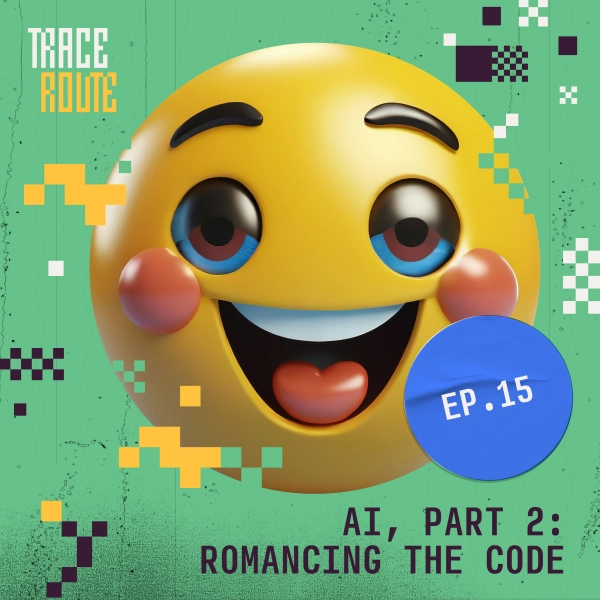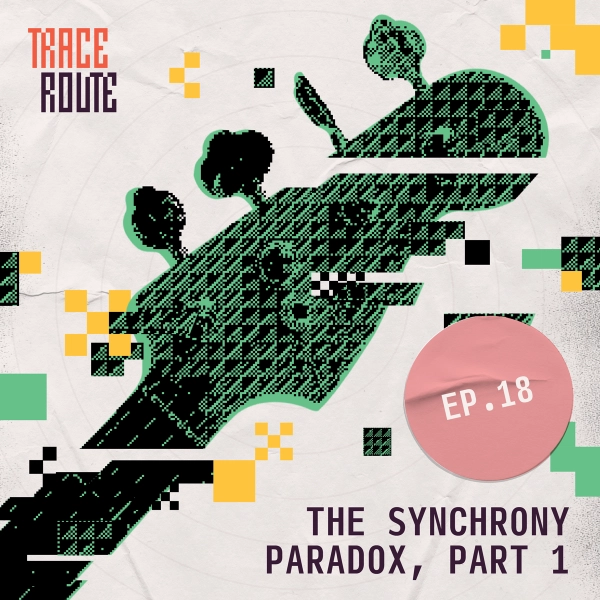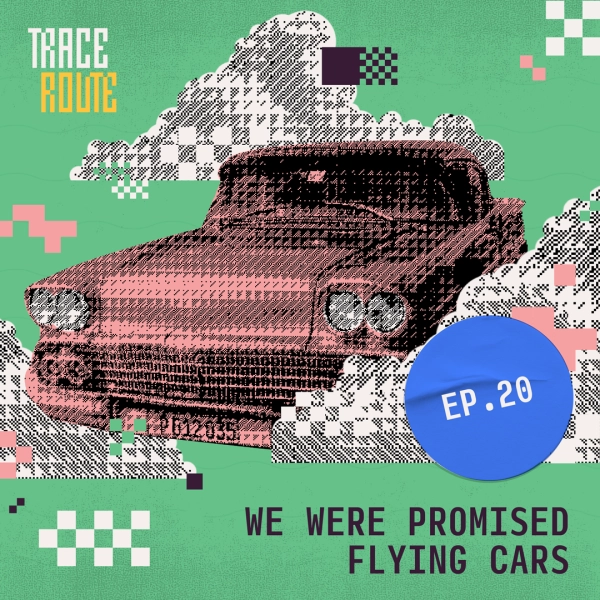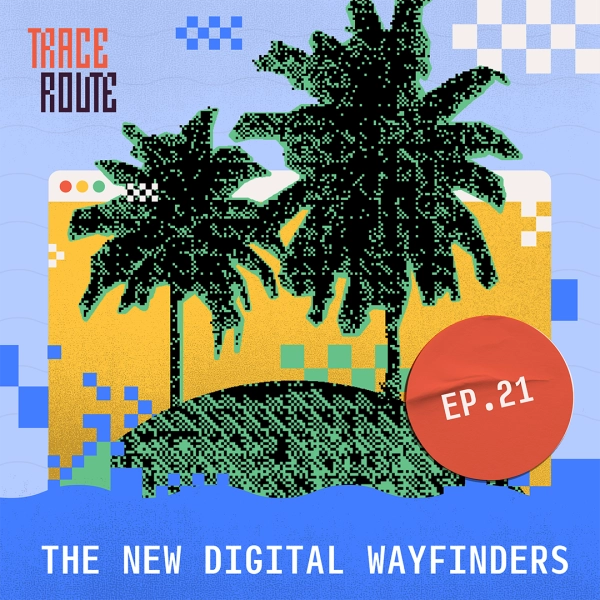Chris Sean isn’t your typical tech influencer. He was homeless and looking for a way to change his life when a YouTube video about Bill Gates convinced him he didn’t need a degree to get into tech. Now, Chris vlogs about his life and career as a self-taught developer to help others like him find their way into the industry. For Chris, creating content is more than a way to make money: it's a mission; it's a vindication.
In this episode of Traceroute, we peek behind the curtain of the exploding influencer marketing industry to understand who’s telling us how to feel about technology and why. We talk to Peter Kennedy, founder of influencer marketing SaaS technology platform Tagger Media, who discusses why tech workers make especially good influencers. We then go in-depth with co-hosts Grace and Fen, whose personal experience as Developer Advocate and Tech Evangelist reveals the greater truth behind this $250 billion industry: exactly who is influencing who?
Grace Ewura-Esi:
You're listening to Traceroute, a podcast about the inner workings of our digital world. I'm Grace Ewura-Esi.
Fen Aldrich:
And I'm Fen Aldrich.
John Taylor:
And I'm John Taylor. Today I'd like to take you all on a little trip on the way back machine. We're going back in time to September 12th, 1962, to President John F Kennedy's speech at Rice University. This is the historic one, the big kahuna, the one that everyone recognizes from the following line. John F. Kennedy: We choose to go to the moon in this decade and do the other things, not because they are easy, but because they are hard.
John Taylor:
I don't know about you, but I just find that incredibly inspirational. I mean, there's a reason why this speech became so iconic. It's the rallying cry for the space age. It's the kumbaya moment that got us to the moon, or was it? You see, the fact is, we had already decided to go to the moon. More than a year before this speech, President Kennedy had announced to a joint session of Congress that he planned on putting a man on the moon before the decade was out. But to get there, the federal government would have to spend almost $190 billion in adjusted US dollars for the Apollo program alone. No one gets that kind of money without a little song and dance. John F. Kennedy: Finally, the space effort itself, while still in its infancy, has already created a great number of new companies, and tens of thousands of new jobs. Space and related industries are generating new demands in investment and skilled personnel, and this city, and this state, and this region, will share greatly in this growth.
John Taylor:
Did you hear it? Did you hear what happened there? Only three minutes after Kennedy makes his awe-inspiring pledge to put a man on the moon, he starts talking about the practical reasons why we should spend billions of dollars on what is literally a pie in the sky project. I believe he knew this going into the speech. Kennedy was a savvy politician. He looked at the polls, he listened to his cabinet. He knew that this moonshot was an expensive and potentially unpopular proposition, but Kennedy was also young and eloquent, charismatic and popular. Why not just stand in front of the cameras and use a little of that old charm to sell this idea to the American public. Boom, faster than you can say Apollo, John F. Kennedy became the world's first tech influencer, or at least that's my theory. According to a PCMag article from 2022, the man who is more universally acknowledged as being the original tech influencer is a gentleman named Brian Dewey. In 1987 Brian was employed by Mutual of New York Financial Services, with the fascinating title of PC Brand Specifier. In 1988, he appeared in an advertisement in PC Magazine stating, quote, "It's my job to select brands of personal computer products for 1500 end users here at Mutual of New York Financial Services. No matter how tough, or how confusing it gets, my boss expects me to be right every time. That's why I have to read PC Magazine." End quote. No one ever looked back from there.
Peter Kennedy:
Well, influencer content performs 300% better than branded content, and on TikTok it's 3000% better engagement.
John Taylor:
That's Peter Kennedy founder at Tagger Media, which is an influencer, marketing, SaaS technology platform.
Peter Kennedy:
If I'm a brand, and I'm going to create content for that customer journey, I'm going to hire influencers to do it, because it's going to perform better. If you think about awareness, consideration, purchase, retention, advocacy, all of that content's being used throughout that process, because it's just performing better.
John Taylor:
How much better? According to Peter, better to the tune of $250 billion a year. Without a doubt, the advent of the internet, and the proliferation of social media, have now made influencers part of our daily lives as consumers. It's a movement that has affected not only the people within it, but the development of technology itself. The question is how much influence do these influencers have, and really who's influencing who? When you think of tech influencers, what's the first thing that pops into your head?
Fen Aldrich:
It's an interesting question.
Grace Ewura-Esi:
I think of developers a lot of time, or I think a lot of marketing. I think of people who are situated within the construct of their company, in a really flexible way. Their work is multidimensional, or multifaceted, and not super straightforward.
Fen Aldrich:
I think I initially gravitate towards the modern concept of influencer, right, in tech. It's the thought there is very modern social media, outward facing, and very direct-to-consumer focused. If I think tech influencer, I'm thinking more like Linus Tech Tips, or any of these tech-focused consumer channels that are very YouTube heavy, and are diving into the latest thing, and whatever it is that's out there, probably a lot more mobile tech, and things like that. Yeah, I guess that's the first place I would think of when I thought tech influencer.
John Taylor:
This consumer-facing, heavy social presence, tech influencer paradigm, is echoed by Peter Kennedy at Tagger. The Tagger platform helps companies identify influencers, then create, manage, and report on influencer campaigns.
Peter Kennedy:
Tech influencers are really interesting, because they are leaders within a specific category, really technology, and they're super good with product reviews, and recommendations. That's why tech companies hire them. They also are the leaders in trends. If we think about... when you look at tech influencers, their main platform is going to be YouTube, for most cases. The reason being is that YouTube has become a search engine. As a new product comes out, people are going to go to YouTube, they're going to search up that product to see what are the reviews, what are people talking about, what are the features? You see a lot of unboxing, and these unboxing things, everyone's like, "Unboxing, that's so weird." Well, no, people actually want to see what the product looks like, and they actually want to see how it performs, and what are the benefits, and cons to it. That's the main platform that we're seeing the most traction with tech influencers.
John Taylor:
In fact, according to data gathered from a thousand tech influencers by Upfluence, YouTube has the highest number of tech influencers on its platform, beating out Instagram by almost 13%. But the biggest difference is the average number of followers on each platform. Tech influencers average over a half million followers on YouTube, but just over 70,000 on Instagram. The reason for this, as Peter explains, is that tech influencers are more likely to be content creators.
Peter Kennedy:
A great influencer, one, is a content creator. They know how to make really good content, but they know how to make content based off of what's important today. Because if you look at influencer content five years ago, it's very polished, it's beautiful, everyone looks flawless. If you look at content today, it's very real. People look like normal people, and they're talking about things that are affecting them, and so they're moving with the trends. It's very real, which is interesting to see. They also listen to their audience, but they don't really listen to their audience, right? Which means that... listen, they're really good at making content, and that's why they have their huge audiences.
John Taylor:
But not always huge, huge audiences. You see, there's another factor at work here. Long-form visual platforms like YouTube allow content creators to reach very specific audiences, like developers who want to switch from C++ to Python, or engineers who need to build an open-source threat intelligence platform with STIX. YouTube also allows creators like Chris Sean to reach developer communities with a very personal approach. If you look you up on your website, or if you just Google you, there's content creator, internet personality, tech influencer, these are all words to describe you. How do you see yourself in that?
Chris Sean:
Someone just trying to share his life, his ups and downs in tech, before and after.
John Taylor:
Right.
Chris Sean:
I want people to see the real... what tech is like, not just what you see on Instagram, not just what you see on the Day in the Life of a Software Engineer on Twitter, Right? But the real ins and outs. Right? There often... it can be more downs and ups, but the pay is great.
John Taylor:
It sounds like we need a little backstory, so why don't you give us the Chris Sean origin story, where you were, and how you got to where you are.
Chris Sean:
Yeah, so interesting story. I think an interesting fact is I shouldn't be alive today. I was born in six months, not nine. I tried to come out in five months. My mom had to go to the hospital, fight me for one month to keep me inside, and then two months later, I almost died again, because my intestines were tied. I shouldn't be alive today. Because I was born so early, I had a... it took time for my brain to actually develop, much longer than a normal guy. I was in special ed, I took the yellow bus, I was very slow, and I became homeless, because I didn't know what I would do with my life for the longest time. I was 26 and I saw a YouTube video from Bill Gates, from Chris Bosch, on how you don't need a degree, and you don't need to be... especially one of those normal nerds you see in school, to become an engineer. I figured, "All right, maybe I can do this." I learned how to code, and got my first job in tech in just three months, fortunately. I happened to make a video on that, out of nowhere with my Note 7 Samsung Plus that almost exploded. Ever since then, I've been documenting my journey from being homeless, to being where I am today in tech
John Taylor:
Because of the uniqueness of your story, that's what compels you to share it with other people. Why both the willingness, and I'm going to say need, to share your story with other people in your content?
Chris Sean:
It's definitely need. It helps me mentally. It's like my diary, but I share with the entire world. When I was learning how to code... so I got my first job in three months, but what I don't often share with people is I tried to learn code the first time, I gave up. I tried looking on YouTube to see if there's anyone that can give me advice as someone who's... there was no one sharing their journey. There's no one vlogging. I did vlog at the first, not anymore. When I got my first job, I told myself, "You know what? If there is no one out there that could have helped me, I'll be that person for other people." Yeah, I'm a junior developer at the time. I barely know JavaScript, and I still got the job. I wanted to be that person that helps them. I never did it for the money, but turns out seven years later, it works out. But I never did it for the money, it was really just to help people. The reason I did this as well, is because of someone named Gary V. I watched him seven or eight years ago, and he said, "If you see no one doing what you want, you be the first person to do it." Fortunately, I was one of the very first people to do what I did on YouTube.
John Taylor:
Chris Sean's story, and the way he interacts with his community, reimagines the definition of the word influencer. Yes, Chris is a YouTuber, and a content creator, and he makes money as an influencer, good money, by the way.
Chris Sean:
November, December combined, I'm making around $40,000 minimum, for maybe 80 hours of work.
John Taylor:
Yeah, that's about $500 an hour, or almost a million dollars a year, if you can keep it up. But again, that's not the point. The point is how Chris, and others like him, redefine the term influencer. Chris is not that outward-facing consumer, consumer-focused, salesperson that Fen had described earlier. Chris's influence is personal. He doesn't sell courses, he doesn't sell anything. He wants to help you change your life. It begs the question, just how much influence does an influencer have? Okay, Grace, you're up. How exactly do you describe your job?
Grace Ewura-Esi:
I'm a human being whose favorite color is cobalt blue. No, I think this is so hard for me to answer, because I have a job title that is not necessarily reflective of the work I do, right? I am a Senior Solutions Marketing Manager. What does that even mean? But internally, the work I do, I handle technical narrative storytelling, which is also maybe a little vague to some people. But the point of my job is to keep our potential customers, current customers, and the market in mind... and not just the financial market, but our community in mind, as we create content that either expresses what we're working on, or explains how to engage with our products, and our platform. Maybe that does make me an influencer in a bit, because I can become, or do, just about anything that feels ethically responsible, and also does not shame my parents... my parents being the company.
John Taylor:
Let's drill down a little bit. As a technical storyteller, who are you telling your story to?
Grace Ewura-Esi:
Officially, I am talking to people who are interested in buying our products and services or who have already purchased, but I think of it as being a little bit bigger than that. I think I'm also talking to a greater community of people who might utilize our product, without necessarily being the ones who are making purchasing decisions. I think that the function of my job, and the way I approach it, is I want to tell informative and engaging stories that help you understand more about how you could use our product, how we fit into your ecosystem of tools, and how we can help you meet your business and organizational goals, or initiatives, or whatever you might have, in an efficient, effective, and hopefully enjoyable way.
John Taylor:
All right. Fen, over to you. Fen, what is your official title? What do you do?
Fen Aldrich:
Oh, I love that Grace and I basically do the same thing, but have approached it from different market segments, and consequently different titles. My official title is Developer Advocate, which is probably the more recognizable form of modern tech influencer, corporate backed title, than... what was the full title that you have, Grace
Grace Ewura-Esi:
Senior Solutions Marketing Manager.
Fen Aldrich:
Solutions Marketing Manager is... well, it's funny, it just encompasses is a little bit more, I think broadly, of the marketing machine that is trying to market tech to largely tech-savvy people. There's a corner of developer relations that's largely like, "How do we market to this segment that's extremely marketing-averse, because they've been fed the pitches. They get so many emails per day of people trying to get them to buy a product." How do you actually talk to these people and say, "Hey, here's a real problem that we recognize is happening in the industry, and here's how we solve it." Generally, when I'm out there and talking to folks, I want to convince people like, "Here is the problem space you might not even recognize you have, or here is the problem space that we do really well in," and try and discuss this. "Here is how things are, here is what's difficult about today. Here's what sucks, and maybe there's a better way we can do this. In fact, if you believe there's a better way we can do this, and you're on board with the way I'm talking about, maybe you should check out our product, because it rolls in the same philosophy of problem solving." That's how I approach this digital storytelling, to the same point as Grace, arguably, and ultimately, the goal is I do want sales to happen, because that's how money ends up in my bank account, and then how I pay my rent, and my bills. But the minute that becomes my goal for my job, it undermines the entire thing. I think Grace has the same approach. If I'm not approaching these conversations genuinely to actually help people out, and without the ulterior motive of driving towards a sale, that gets sniffed real quickly. The roles that I've always seen developer advocate, or technical evangelist, or developer relations, or some role of this type, has to be that genuine pre-sales approach of like, "Can we actually help each other? Is there a way I can teach you something? Is there something we can learn?" Maybe it's like, "I just taught you a skill," or, "I just taught you that this entire product segment exists, and you need to dive in and understand more, before you're even thinking about purchasing it, or using it." But we had this moment, and we both walk away better for it, from having this conversation.
John Taylor:
Let's talk about how you deal with the community, keeping all these things in mind that we talked about earlier, your reputation, and wanting to provide actual solutions, and how do you then make that approach to the community?
Fen Aldrich:
There's a fair share of what I do that is going back to marketing and saying, "Hey, here is what I'm seeing, and this is really landing with people, and what's taking off, and what we should be talking about," or, "Yeah, hey, this AI discussion seems to be going this way. Maybe we should be talking about this, and weighing in on it," or, "DevOps is losing its buzz wordiness. What else can we talk about?" Right.
John Taylor:
Got it, and how much influence do you have in that, when you are going back to the company and saying, "This is what I'm hearing from the community"?
Fen Aldrich:
I was at Elastic during the time that they changed up their licensing to shift more... it was a very bizarre moment. They had an open source, open core project, that was all licensed under classic open source Apache 2 licensing, and they had paid product that was licensed under various tiers of payment, from free, to gold, or platinum, or whatever else, based on your business needs. The first part of the decision was to merge the two repositories into one big code base. This was poorly marketed, and needed much more time with community talking about why it was happening, because people just saw this as a, "You're making it difficult to contribute in creating a copyright," trap. There's lots of understanding why this is happening. Code was shifted to try and protect the IP of Elasticsearch from not being run on Amazon, and being called Elasticsearch code unchanged, because we were also starting to open source some of how we were hosting that... not open sourcing it, but opening the code. There was some copyright concerns about people stealing how we did stuff, but the main thing was it was really hard to operate on a code base that was in two different repositories, and keep it in sync. Right? It was hard to operate on this connected code base, between open source free and paid, without actually having them all in the same place. There was a big developer headache trying to do that, and merging this. While it took a lot of effort, alleviated a ton of efforts on our engineering for release team, and all of this other stuff. But that wasn't talked about. What was talked about was all of this licensing change, and how it's confusing, and all of this other sort of thing, and weren't clear about that. We had some issues agree. I also disagree with some of the licensing changes, but it did split the entire Elasticsearch code base into Elasticsearch and Opensearch, and it had a big falling out in the community. A lot of people abandoned the Elastic branded thing, in favor of this other thing, because of that. I think that was something that as DevRel and community, at the time, in that company, I was like, "Hey, this is a big fallout for the community. I think this is a bad change. We're not communicating it well."
Grace Ewura-Esi:
I think the kind of influence you're talking about, John, where you're impacting dollars, like really impacting dollars, I'm talking hundreds of thousands, maybe a couple of million. I think that sometimes that level of influence that you're talking about is when you are able to say, "Hey, we're testing this product functionality. People don't like it. People aren't using it that way."
Fen Aldrich:
Yeah, yeah.
Grace Ewura-Esi:
I've had past jobs where we got to run alphas and betas, but running the alpha is really the gag. But we were able to show people a product offering, get their opinion, and as influencers, take that feedback back to product engineering and say, "Yo, I don't know what y'all thought this was supposed to do, but nobody likes it, and it's not doing what you want it to do." You'll derail products and plans, but you can absolutely help the company in the way in which they engage with their own offering, by having those relationships, and they being honest enough to be candid. I have had jobs in the past where I've been able to do that, or be a part of teams who did that, where we're like, "People don't want this functionality," and we weren't always listened to. The truth of the matter is, just because you've collected the experiences, the stories you have the exposure, you've built the community, it doesn't mean that the product roadmap of the company that you are influencing for is going to be receptive to that friction you're providing.
John Taylor:
But more and more tech companies are becoming open to that kind of friction, and that kind of feedback, coming from a person who has influence within the community they're serving. This is something Peter Kennedy has seen firsthand.
Peter Kennedy:
Then we start to see these technology companies bringing in these influencers into what we call the boardroom. Right? "We're thinking about new product launches, let's bring them in the boardroom. Let's get their advice on what products we should be launching, what features are important." The reason why that's happening is because they're sending out content all the time. They're getting messages, comments from all these different people, around the world. They know what's going to work, what's not going to work. Frankly, every brand category are bringing these people into product development, product strategy, even marketing strategies.
John Taylor:
You're seeing that across the board, that influencers are having an influence on the product that's being developed.
Peter Kennedy:
Correct, yes. I mean, the reason why we think about influencer marketing in our platform as social listening. It's like, what's happening within the space, but we only focus on influencers. Why? Because I don't really care what I have to say out there, right? Because I don't really have a huge audience, and it doesn't really matter what I have to say. But influencers are people who have move culture. I mean, I don't know if you remember Corn Kid, but it's a video about corn. It moved the corn commodity market. I mean, that is the power of these people. Yeah, it's pretty amazing what levers they can pull within our society, but also what levers they can pull within these companies, to help drive the product roadmap.
John Taylor:
Well, I'm not exactly sure young Tariq actually moved the corn commodities market, but he was in fact made South Dakota's official cornbassador, so that's pretty cool. There's a saying that goes something like, "In the future, everyone will be famous for 15 minutes," and maybe influencers are the manifestation of that prophecy, word of mouth, right? There's no greater marketing than word of mouth. Maybe John F. Kennedy knew, on that fateful day in 1962, that a mouth that happens to have millions of listeners is one of the most powerful, and influential, tools at our disposal. Influential enough to put a gadget in your pocket, or a man on the Moon.
Mathr de Leon:
Traceroute is a podcast from Equinix and Stories Bureau. This episode was hosted by Fen Aldrich, and Amy Tobey, and was produced by John Taylor, with help from Sadie Scott. It was edited by Joshua Ramsey, with mixing and sound design by Brett Vandalon, and additional mixing by Jeremy Tuttle. Our fact-checker is Ena Alvarado. Our staff includes Tim Ballant, Susie Falk, Lisa Harris, Alisa Manjarrez, Stephen Staver, Lixandra Urresta, and Rebecca Woodward. Our theme song was composed by Ty Gibbons. You can check us out on X @equinixmetal, and on YouTube at Equinix Developers. Visit Traceroutepodcast.com for even more stories about the human layer of the stack. Of course, we're going to leave all these links, and a link to the transcript, down in the show notes. If you enjoyed this story, it'd be great if you could share it wherever you hang out online. Lastly, it would mean so much if you could find time to drop us a rating on Spotify, and maybe a rating and review on Apple, because let's face it, we're all just pandering to the algorithm. Mathr de Leon, Senior Producer of Traceroute, and we'll be back in two weeks with a brand new story. Until then, thanks for listening.
- Traceroute is a podcast from Equinix and Stories Bureau.
- This episode was hosted by Amy Tobey and Fen Aldrich, and was produced by John Taylor with help from Sadie Scott.
- Our senior producer is Mathr de Leon.
- It was edited by Joshua Ramsey with mixing and sound design by Brett Vanderlaan and additional mixing by Jeremy Tuttle.
- Our fact-checker is Ena Alvarado.
- Our staff includes Tim Balint, Suzie Falk, Lisa Harris, Alisa Manjarrez, Stephen Staver, Lixandra Urresta, and Rebecca Woodward.
- Our theme song was composed by Ty Gibbons.






